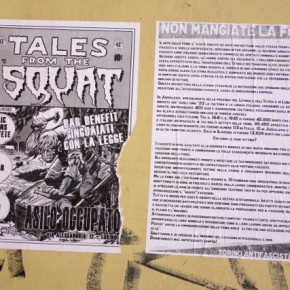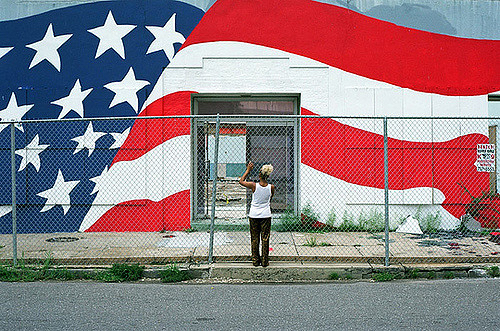On Friday evening, Justin Bieber visited the Anne Frank House. On Saturday, the museum shared that information on its Facebook page. Along with a portrait of the nineteen-year-old singer, staff reported Bieber comparing the Holocaust heroine to one of his fans.
‘Yesterday night Justin Bieber visited the Anne Frank House, together with his friends and guards. Fans were waiting outside to see a glimpse of him. He stayed more than an hour in the museum. In our guestbook he wrote: “Truly inspiring to be able to come here. Anne was a great girl. Hopefully she would have been a belieber.”
On Sunday, the Internet went wild. The news was trending everywhere, on twitter, on Facebook, and in the news. Gawker highlighted the young star’s entry in their headline, and posted a photo of him ‘swagging’ out of the museum. Emmy Rostrum tweeted her disgust, which was reported by the rightwing Algemeiner. Reports appeared on the BBC, in the Guardian, on CNN, and, well, just about everywhere.
I won’t jump on this bandwagon. Oh, sure, I made the ‘despite everything, I still belieb people are good at heart’ joke. But this was not an occasion to become angry, but to reflect on this widespread anger.
The mainstream reports, the Twitter jokes, and the multitude of comments on Facebook (2,375 at last count, with 3,274 shares) all had one thing in common: They indicated there was a proper message to receive and an acceptable way to engage with Anne Frank.
Not so long ago, Kelly Osbourne visited the museum; the guest book inscription (also shared on the Anne Frank House facebook page) praised Anne for ‘telling your story and showing the world what really happened; because apparently, she ‘changed the world’. Her entry made significantly less news, probably because it adhered to the acceptable reading: It treats the diary, a chronicle of a time in hiding as a report of genocide. Osbourne treats an as exemplar and praises the transformative potential of the text, its author, and the museum itself. All these elements converge on a single, sacred site, and Osbourne knew well enough to treat it as such.

Now, there is no question that Bieber’s comments were self-serving and a tad narcissistic, but let’s face it: He is still a teen, and one who has received a ridiculous amount of attention to boot. But what I find touching is that his comments recognise Anne as a young girl—one whose walls were plastered with photos of celebrities. Intentionally or not, his comments recall the human in the icon of the Holocaust. And there is a definite appeal to that because this latter aspect came after her death, not during her short life.
Anne Frank certainly had an interest in creating a record. When Gerrit Bolkstein, a Minister of the Dutch government in exile, announced his intention to produce a collection of wartime diaries and letters, Anne set to transforming her private diary of life in hiding into a public testimony—a witness to her life during what would come to be known as the Holocaust.
However, embedded in that are the musings on teenage romance, adolescent biology, and fractious family relations that have made the diary so appealing to so many people. And embedded in that diary is someone we would today consider a young fan. A number of the original entries were crafted as letters to her favourite characters from Cissy Van Marxveldt’s Joop ter Heul series. The ‘Kitty’ we know was among this cast of players.
Some years ago, I discovered videos to Anne Frank, posted on YouTube. It seemed that teenage girls around the world were producing slideshow commemorations or remixed clips from the films about Frank, all set to pop music, from Celine Dion’s ‘My Heart Will Go On’ to ‘Kiss the Girl’ recorded by High School Musical star Ashley Tisdale. It would be tempting to read these as foolish or misguided, flouting the appropriate response required of Frank and her diary. But I found them touching, and in keeping with her own inventive approach to keeping her diary, as well as her delight in celebrity. Who is to say this isn’t another way of venerating, adoring, and paying tribute to the diary and its author?
I’m all for arguing about whether she’d actually like the music of Justin Bieber (I’d like to think she wouldn’t.) But I’m not so sure that thinking about Anne Frank, as a girl and as a fan, is necessarily a bad thing. It certainly doesn’t seem to me to be the blasphemy that so many treat it as. (And consider: the Anne Frank House posted this entry without critique, but with excitement over a celebrity guest who was drawn to learn more about the girl after he read the diary.) In fact, I rather like the fact that there is someone remembering the young girl in the diary.
Leshu Torchin contributed the chapter ‘Anne Frank’s Moving Images’ to the collection Anne Frank Unbound: Media, Imagination, Memory ed. Barbara Kirshenblatt-Gimblett and Jeffrey Shandler (Indiana University Press, 2012).
Photographs courtesy of NRK P3 and elycefeliz. Published under a Creative Commons license.






I guess I didn’t have the same reaction to his words as most did. While many see it as shameless self-promotion, I also find it a touch poignant… when I translate it as “I’m a fan of yours… I hope you would be a fan of mine.” Is he just a fop who thinks of his fans as mindless followers… or was he sincerely hoping that someone as “great” as Anne Frank would find something admirable in what he does?
I’m not a fan of “The Beib”, but sometimes I wonder if there is a boy under the bubble-gum pop veneer who missed out on growing up normal. At least he still has time to make a positive mark on the world. I hope he finds Anne Frank, and people’s reactions in defense of her, inspiring.